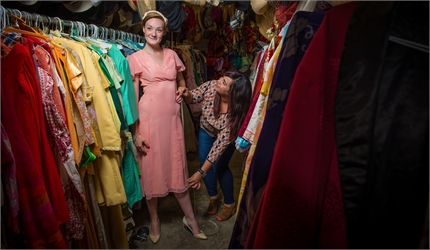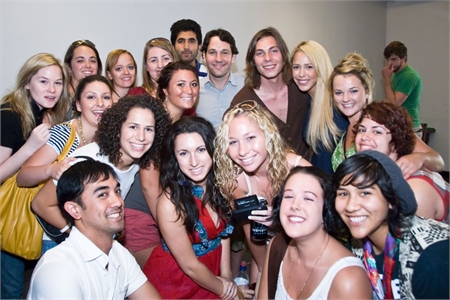130 Years of Excellence
Celebrating 130 Years of Excellence.
6417.jpg)
Perhaps the one thing that most Hollywood stories have in common is the element of chance coupled with a bit of fantasy. While the American Academy of Dramatic Arts’ reputation and illustrious alumni speak strongly, the unlikely scenario of the DeMille dynasty playing a key role in its New York beginnings and on a second campus in the town where the DeMille name has even a greater impact is part of modern day Hollywood lore.
Originally established in New York City as the Lyceum Theatre School of Acting in 1884 by Franklin Haven Sargent, a Harvard University speech professsor, it was shaped by several luminaries of its day, including playwright Henry DeMille (father of you know who). It was Henry who gave the school the name it would carry to Hollywood 117 years later.
Prior to The Academy, actors were trained primarily through stock companies and a trial and error approach. Under Sargent’s direction, the original ciriculum was based on the early teachings of Francois Delsarte and and later other masters of acting technique. In 1896, Sargent noted that other acting schools that by then had been established throughout the country were under the direction of either a graduate or a former teacher. The first acting school in America, The Academy contributed to a major shift in the presentation of live theatre advocating and teaching students to bring “truth to imaginery circumstances.”
By introducing a formal education process, it could be said that The Academy legitimized the profession and today scores of actors credit its teaching with their success. Grounded in stage technique, its alumni roster includes such early Hollywood film stars as Edward G. Robinson, William Powell, Spencer Tracy, Pat O’Brien. Rosalind Russell, Kirk Douglas and Lauren Bacall.
In addition to its training, the school helps prepare its students for the realities of a profession where education does not always equal success. Acting provides the possibility of great fun and fulfillment as well as the likelihood of considerable frustration and struggle. Success in acting requires, among other things, a level of perseverance similar to that of any extremely challenging goal. The Academy’s primary purpose is to serve those who want to spend their lives as actors. While some students may ultimately choose other paths in their lives, all students are expected to make a commitment to professional excellence and discipline.
 Intensive training at a drama school of the sort offered at The Academy involves a student’s whole being, and the time spent is, inevitably, an important period of intellectual and physical development as well as imagination and risk taking.
Intensive training at a drama school of the sort offered at The Academy involves a student’s whole being, and the time spent is, inevitably, an important period of intellectual and physical development as well as imagination and risk taking.
Watching a Movement Class as the instructor put students through their paces leaves no doubt that something special is happening here. Bright, alert faces atop energetic and coordinated bodies clearly demonstrate dedication, motivation and desire. These are first year students among 150 accepted into study at the West Coast campus. Culled from 3,000 applicants, some will continue and be accepted into The Academy’s Company, the 25-member acting ensemble only for third year students.
At each stage of development, students’ classroom knowledge is evaluated through performance projects, scene work or onstage performances. At the completion of each year, students are invited to continue and must meet certain benchmarks. This is a criteria each student knows before enrolling.
Their commitment is supported not only by the teaching staff, but by costumers, set designers and other technical staff who give students the experience of working with professional theatre people. The campus includes set construction shop, a bungalow filled with props, an extensive costume collection, four television studios, and two theatres, black box and main stage proscenium.

For the serious, motivated student who is ready to make a commitment to acting-and to concentrated professional training-The Academy offers much more than a long history of success. It offers a well-balanced and carefully structured curriculum, a qualified and caring faculty, and the rare chance to follow in the footsteps of its illustrious alumni and pursue a life’s dream.
Today the goal of the Academy is to prepare students for acting careers in theatre, television and film. Its stated purpose is to provide a practical, post-secondary education that emphasizes the skills needed by an actor in today’s competitive environment. Its national and regional accreditation ensures that if a student transfers to another school, their credits will be accepted.
Its training program is unique, based upon the long tradition of The Academy and embraces modern methods that promote discipline and self-discovery, along with the development of technique. Its faculty consists of working professionals and master teachers. They lead students to deeply felt, psychologically true and physically realized performances. Students receive constant feedback from an engaged and dedicated faculty.
Academy connections have been developed with theatre artists, professional theatres and educators worldwide. The growth of The Academy’s international student body has been remarkable by any measure. Students come from varied backgrounds and from all around the world. Diversity helps give students exposure to many cultures, enriching the depth of the actor’s work. Selectivity yields a pool of students who nourish each other’s growth.
Like any institution, the Academy has grown and evolved. Its founder remained at the helm nearly 40 years and one of its first graduates, Charles Jehlinger, succeeded him until his death in 1952. In 1963, then president Academy alumna and veteran Broadway actor, Frances Fuller, moved the school to its midtown Manhattan location which it remains today. Ten years later in 1974, The Academy established a West Coast campus in Pasadena where it remained until 2001 when it purchased property formerly A&M Records on the south lot of the former Charlie Chaplin Studios in Hollywood.
Throughout its history, Academy faculty and administrators have been among the most progressive theatrical theorists and visionaries of their day, and today are actively influencing the field of actor training and theatre practice.
The Academy alumni list is an impressive one, with prominent names from all aspects of the entertainment industry, past and present. As a group, The Academy alumni hold a total of more than 103 Oscar®, 266 Emmy®, and 90 Tony® nominations plus 5 Kennedy Center Honorees. This year actor Paul Rudd joined 43 others as he received his star on Hollywood’s Walk of Fame. The numbers grow every year.
During the 20th Century The Academy became widely known as the “Cradle to the Stars” because of its glittering array of alumni that now includes Robert Redford, Danny Devito, John Cassavetes, Gena Rowlands, Anne Bancroft, Cleavon Little and Grace Kelly. This legacy continues into the 21st Century with The Academy alumni such as Christine Ebersole, Paul Rudd, Kim Cattrall, and Dennis Haysbert to name a few.
Tony award-winning Christine Ebersole noted in an interview for Backstage “The Academy was a great experience for me. It taught me a great work ethic and the importance of servicing the piece that you’re working on-taking your ego out of it and bringing your talents to it, helping it to be realized through your other team members. It made me realize that acting is really a team sport.”
With its unique training program and incomparable heritage, advanced methods of instruction, an exemplary faculty and leadership committed to the same standards of excellence that have made The Academy foremost in its field, its future and that of future generations of actors in New York, Hollywood and throughout the country is ensured.
And this is where the story comes full circle, in 1912, Jesse Lasky and Cecil B. DeMille made their way west, using the Hollywood countryside as their outdoor stage. It was at The Academy in New York where that saga began…a perfect Hollywood ending.